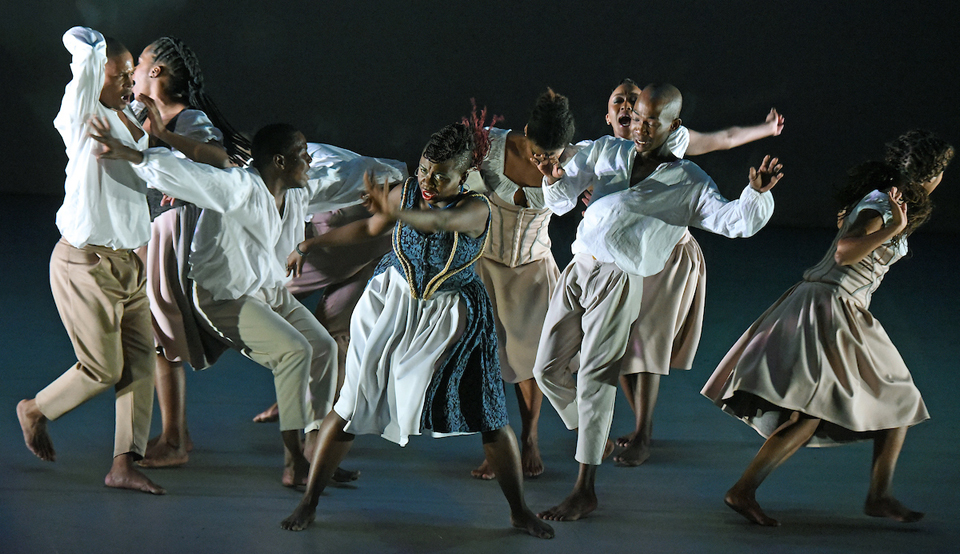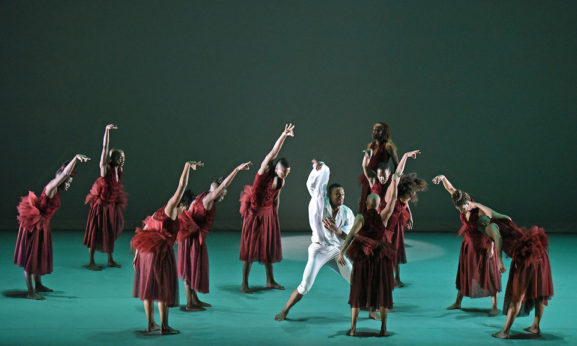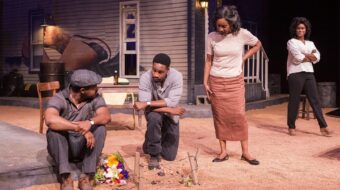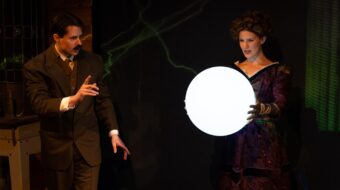
BEVERLY HILLS—It’s a common fantasy: Your man betrays you and you threaten him by saying you’ll become a ghost, a spirit, or a wili, and haunt his every waking—and dreaming—moment. Such threats may not always be taken literally, but may give a man a good case of the “willies” as he thinks twice about how he treats a woman.
This is basically the premise of the classic 19th-century French ballet Giselle, whose music was written by Adolphe Adam, the forward-looking composer of the “Cantique de Noël” or “O Holy Night.” One verse of the carol (which caused it to be banned from many churches, especially in the South) states: “Truly he taught us to love one another; his law is love and his gospel is peace. Chains shall he break, for the slave is our brother; and in his name all oppression shall cease!” Now there’s something worth taking literally!
A country girl named Giselle is courted by a handsome stranger Albrecht (calling himself Loys), who seduces and then abandons her for another higher ranked woman. Heartbroken, Giselle dies, but cannot rest in peace. She is transformed into a wili, a dance-obsessed ghost, bent on joining her fellow wilis—other women who have died of similar heartbreak—to force Albrecht to dance until he expires of exhaustion. A great scenario for spectacular exhibitions of choreographic prowess!
The very word “willies” is thought to derive from Adam’s 1841 ballet, although there are alternative interpretations of the word as well. Some men in the audience unexpectedly seeing the wilis on stage must have taken a little fright seeing those angry, unrepentant, justice-exacting women take their revenge. Their companion that evening at the theatre might turn into a future wili!
Opera cognoscenti will recall that Giacomo Puccini’s first opera was Le Villi (1884), based on this same story. Its U.S. premiere in 1908 at New York’s Metropolitan Opera was conducted by Arturo Toscanini.
Enter Dada Masilo, pioneering South African ballerina and choreographer, hailed on several continents for her stunning feminist revisions of Carmen, Romeo and Juliet, and Swan Lake. She recently brought her company, based in Johannesburg, to the Wallis Annenberg Center for the Performing Arts in Beverly Hills for a three-performance run of Giselle April 12-14. It now travels to Fairfield, Conn., for a single performance on April 18 before the troupe heads home.
Stylistically, the ballet retains much of the choreographer and lead dancer’s classical ballet training, which other company members also shared. The 13 company members were all invited to return to the stage in a talk-back immediately following the first performance on April 12 hosted by The Wallis’s Artistic Director Paul Crewes. They described their early attraction to dance and their personal histories with the company. Most joined between 2010 and 2014.
But at the same time most of these dancers also were exposed to contemporary dance techniques, jazz and popular music, and native African dance traditions. These influences are very much part of the work. Uncharacteristically for classical ballet, the dancers engage in a certain amount of chanting, singing, speaking and shouting. A Hamba Nhliziyo Yami traditional funeral hymn for Giselle (Dada Masilo) is sung, translated as “Go to heaven my heart, for there is no peace on this earth.” And when Myrtha, Queen of the Wilis (Llewellyn Mnguni), summons her terrifying spirits to the final dance, she also speaks in her African language, saying, “I’m calling all of you! Here is a man who is breaking hearts! Catch him!”
The score for the South African Giselle is not by Adolphe Adam, but rather by the Cape Town-based composer and sound artist Philip Miller, featuring vocals, African drums, cello, violin and harp. So far as I could tell, it only references Adam’s score in suggesting a mood for each scene. It’s modern, tribal, percussive and rhythmic, and listenable.
The dance movements are by turns lyrical in love, mechanical and forceful in depicting work routines, haughty and sneeringly rebellious when it comes to class relations, humorous when there’s drink involved, fidgety and anxious when Giselle is exposed as the victim of Albrecht’s (Xola Willie) infidelity. Giselle suffers a humiliating downfall, stripped almost naked down to her skivvies, baring her embarrassment with shame but also defiantly, knowing she has done no wrong. Albrecht’s final agonizing possessed convulsions are handled convincingly from a dramatic and physical point of view. The sheer athleticism of the work is astonishing and exhilarating.
The corps de wilis notably also includes a couple of men dressed like the other wilis, in a bright red sort of tutu-suit. The company comprises six men and seven women, so that helped make the wilis a little larger group—and may suggest that men can be exploited and abandoned by their lovers too.
The original Giselle participates in the tormenting of her false Albrecht, but just before he is about to die from an excess of grand jetés, she has a pang of loving remorse for him, kisses him and sends him back home alive. It is her act of forgiveness that allows her to achieve the eternal rest that resentment has denied her. It’s a satisfying Christian message for Catholic France. Although momentarily shaken by the “willies,” the good bourgeois two-timers in the audience can leave the theatre somewhat relieved that their sins will not be punished by eternal damnation. After all, that’s what confession is for, and if you don’t confess, well, there’s always the saving balm of forgiveness.
Dada Masilo will have none of this, however. Why bother with a new Giselle if that’s all you have to say?
“In this Giselle,” she says in a program note, “I aimed to create a work that is not about forgiveness, but rather is about love, deceit, betrayal, anger and heartbreak. I strove to create new movement vocabulary and to push myself in terms of story-telling. In the traditional ballet, there is a clear narrative, but the characters are somewhat two-dimensional. I wanted to go much deeper and most importantly, to create Wilis that are really vicious.”
Here, Giselle is also released from her mortal bonds, but not through forgiveness, rather by revenge. This ballet premiered in Oslo in May 2017, and could be considered contemporaneous with the #MeToo movement.
In the talk-back, Masilo expanded on her conceit, saying, “I really wanted to find the vicious, the dangerous and the strong” in the Wilis.
A questioner asked, “Doesn’t it take more strength to forgive than to take revenge?” Masilo answered, “Forgiveness has been done. He doesn’t deserve it.”
Another audience member asked, “Does this mean Truth and Reconciliation is over? Your South African model for conflict resolution has been admired and imitated throughout the world.” Masilo relied, “I think it’s time for women to take a stand at some point.” (Applause from the audience.) And to another question about the introduction of speech and dialogue into the ballet, Masilo said, “South Africans are loud. There are times when movement is not enough: You have to vocalize.”

Although coming at a time of heightened women’s outspokenness about sexual exploitation, this Giselle does not have to depend on external movements for its inspiration. At home in South Africa, male privilege runs rampant, perhaps neither more nor less than other places, but certainly objectionably. Accusations against the former President Jacob Zuma focused on his sexual exploits alongside his financial dealings and favoritism.
Statistics about HIV infection indicate that three of South Africa’s immediate neighbors present the highest rates in the world: Swaziland at an estimated 26 percent, followed by Botswana with 23.4 percent and Lesotho at 23.3 percent. South Africa’s infection rate is 17.3 percent, but with its much larger population, that translates to 5.6 million people living with HIV, making South Africa home to the world’s largest epidemic. Many are the women infected unsuspectingly by their husbands or lovers; and the country’s health ministry has a mixed record of responsiveness to the disease. At times in the past, successful medications were intentionally withheld because they were deemed “Western” and “imperialist.” Thousands died owing to stupid men’s willful ignorance and prejudices.
Giselle makes no reference to such numbers about HIV, but the disease is a haunting presence throughout the land. No wonder women and men both feel “the willies” when it comes to dealing with sex, love and abandonment in South Africa.
Leaving the theatre, I overheard a man near me say he’d better not continue dating the two women he was seeing; might be best to concentrate on one. Art imitates life or life imitates art? Could be some of both.












Comments